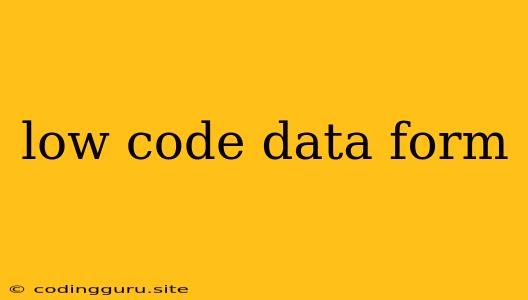Unlocking the Power of Data with Low-Code Forms: Building Better Applications Faster
In the ever-evolving landscape of software development, time is of the essence. Businesses demand rapid development cycles and efficient solutions to stay ahead of the curve. Traditional coding methods, while powerful, can often be time-consuming and require specialized skills. This is where low-code data forms emerge as a game-changer, empowering businesses to build robust data-driven applications without the need for extensive coding expertise.
What are Low-Code Data Forms?
At their core, low-code data forms are visual interfaces that allow users to create and customize data input forms without writing complex lines of code. They provide a drag-and-drop approach, simplifying the process of building forms for various purposes, including:
- Customer surveys: Gather valuable feedback from your audience.
- Lead generation: Capture key details from potential clients.
- Event registration: Organize and manage attendees for your events.
- Employee onboarding: Streamline the process of welcoming new hires.
- Product feedback: Collect insights from customers about your offerings.
Benefits of Using Low-Code Data Forms:
1. Rapid Development: The visual interface and intuitive drag-and-drop functionality significantly reduce development time. You can quickly create and deploy forms without the need for extensive coding knowledge.
2. Enhanced User Experience: Low-code data forms often come with pre-built templates and customizable elements, allowing you to create visually appealing and user-friendly forms. This improves the overall user experience and encourages higher engagement.
3. Increased Accessibility: No coding expertise? No problem! Low-code data forms make data collection accessible to everyone, empowering non-technical users to build their own applications.
4. Improved Data Quality: Low-code data forms can be configured to enforce data validation rules, ensuring data accuracy and consistency. This reduces errors and minimizes the need for data cleaning later on.
5. Cost-Effectiveness: By eliminating the need for extensive coding resources, low-code data forms significantly reduce development costs. This allows businesses to allocate their resources more effectively and focus on other priorities.
How to Choose the Right Low-Code Data Form Platform:
With numerous low-code data form platforms available, selecting the right one for your needs can be challenging. Here are a few key factors to consider:
- Features and Functionality: Determine the specific features and capabilities you require, such as data validation rules, integrations, reporting, and customization options.
- Ease of Use: Choose a platform that is intuitive and easy to navigate, even for non-technical users.
- Scalability: Ensure the platform can handle your data volume and future growth requirements.
- Security: Prioritize platforms that offer robust security features to protect your sensitive data.
- Cost: Consider the pricing model and compare different options to find the best value for your investment.
Examples of Low-Code Data Form Platforms:
- Zoho Creator: A comprehensive low-code platform offering powerful features for data form creation, data management, and application development.
- Appian: Known for its robust workflow automation capabilities and integration with various enterprise systems.
- Mendix: A leading platform for enterprise-grade application development with strong data modeling and visual development tools.
Tips for Building Effective Low-Code Data Forms:
- Keep it simple: Avoid overwhelming users with too many fields or complex questions.
- Use clear and concise language: Ensure that your questions are easily understood and unambiguous.
- Provide helpful instructions: Guide users through the form with clear instructions and visual cues.
- Test thoroughly: Validate your form before launch to ensure it functions as intended and captures the desired data.
Conclusion:
Low-code data forms offer a powerful and accessible way to build data-driven applications without the need for extensive coding expertise. By embracing the power of low-code data forms, businesses can streamline data collection, improve efficiency, and gain valuable insights into their operations. The future of application development is increasingly low-code, and this technology holds immense potential for empowering businesses to build better applications faster and more effectively.
